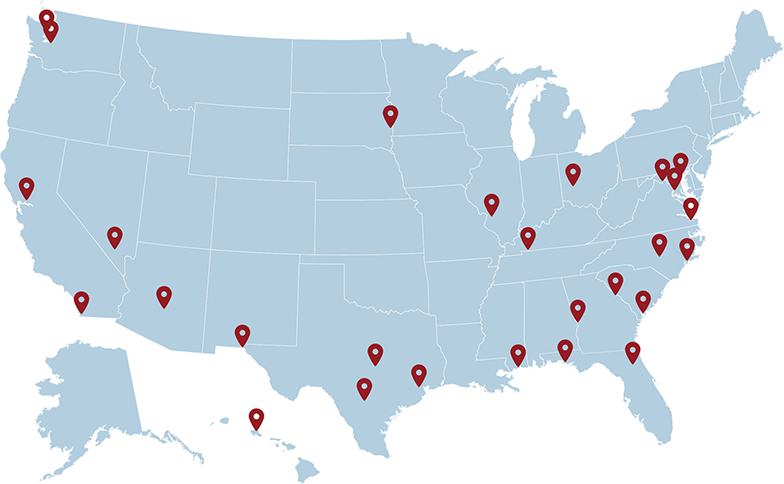
Clerkship OPPORTUNITIES AT USU
Our students have the unique opportunity to complete clerkships at military hospitals around the country. From psychiatry with veterans in Hawaii to active duty sailors on ships in Portsmouth, our clerkships provide students unique experiences that span the full spectrum and geography of military medicine. Working in military hospitals all over the country ensures that students get the chance to work with many patient populations in the military health system including veterans, active duty members, and children.
Our core clerkships are nested with military residency programs, allowing exposure and networking for residency early in medical training. Not only do our clerkships provide a robust clinical foundation, our students learn clinical medicine while providing care for active duty and retired military members and their families.

LOCATIONS
There are 24 locations for Core Clerkships throughout the United States, and even more choices for Selective and Advanced Clerkship Rotations locations every year.
- Beaumont Army Medical Center
- Bremerton Naval Hospital
- Eglin AFB Hospital
- Fort Belvoir Community Hospital
- Fort Benning Martin Army Community Hospital
- Fort Bragg Womack Army Medical Center
- Fort Gordon Eisenhower Army Medical Center
- Fort Hood Darnall Army Medical Center
- Howard County General Hospital
- Inova Fairfax Hospital
- Keesler Medical Center
- Madigan Army Medical Center
- MedStar Union Memorial Hospital
- Nellis AFB O'Callaghan Military Medical Center
- Naval Hospital Camp Pendleton
- Naval Hospital Jacksonville
- Naval Medical Center Camp Lejeune
- Offutt Air Force Hospital
- Pensacola Naval Hospital
- Portsmouth Naval Medical Center
- Psychiatric Institute of Washington, DC
- San Antonio Military Medical Center
- San Diego Naval Medical Center
- Travis AFB David Grant USAF Medical Center
- Tripler Army Medical Center
- VA Hospital of Washington, DC
- Walter Reed National Military Medical Center
- Wright-Patterson Medical Center
20% hospital locations for Core Clerkships
30+ Selective rotations available
140+ course options for Advanced Clinical Rotations
40+ Advanced Clinical Rotation sites worldwide
TIMELINE
Involvement in clinical clerkships begins in January of Year 2 and continues through the end of a student’s time at USU. Rotations in the core clerkships are completed in three 15-week blocks from January of Year 2 to December of Year 3. Following completion of the core clerkship year, students have a dedicated six-week Step 1 study block. Completion of the Step 1 examination is followed by participation in the “Bench to Bedside and Beyond” phase of the curriculum, which includes training in Advanced Life Support (ALS), Advanced Trauma Life Support (ATLS) and advanced academics focusing on the integration of basic science and clinical medicine. Advanced Clinical Rotations begin in the early spring of Year 3 and end a few weeks before graduation. These are 12 blocks of four-week rotations with three required rotations (Anesthesia, Emergency Medicine, and Neurology). The remainder are student-selected based upon future career plans and are designed in coordination with the guidance from the Office for Student Affairs.
EXPENSES
Core Clerkships: ALL EXPENSES PAID - travel to/from, lodging, and per diem/board if authorized.
Core Selectives: ALL EXPENSES PAID - travel to/from, lodging, and per diem/board if authorized.
Required Subject-Specific Clerkships: ALL EXPENSES PAID - travel to/from, lodging, and per diem/board if authorized.
Required Sub-Internships: NO EXPENSES COVERED
Advanced Selective Clerkships: NO EXPENSES COVERED
One Interview Rotation: All Expenses Paid except rental car
CORE CLERKSHIPS
The core clerkships build on many of the basic science "threads" -- the fundamental anatomic, physiologic, and pathologic concepts that were introduced in the pre-clerkship modules. Clinical threads focus on topics of medical professionalism, ethics, patient safety, quality improvement, the skills necessary to practice lifelong learning, and on evidence-based medicine. They begin in January of Year 2 and end in December of Year 3.
Following a one-week orientation session in which students are introduced to their roles and responsibilities associated with the inpatient and outpatient clinical environments, they participate in a total of 48 weeks of required clinical clerkships, which are accomplished in three 16-week blocks. The core clerkship rotations are five weeks each and may be completed in any order. The paired clerkships are 10 weeks long and include Medicine (Inpatient and Outpatient Medicine) and Surgery (General Surgery and Surgical Subspecialties). Blocks may be completed in any order, but each block involves completion of a paired set of clinical clerkships that incorporate the integration of key clinical and basic science themes or "threads."
Core clerkship rotations: Family Medicine, Gynecologic Surgery & Obstetrics, Inpatient Medicine, Outpatient Medicine, Pediatrics, Psychiatry, Selective (four weeks plus one week of leave), Surgery, Surgical Sub-specialties.